-
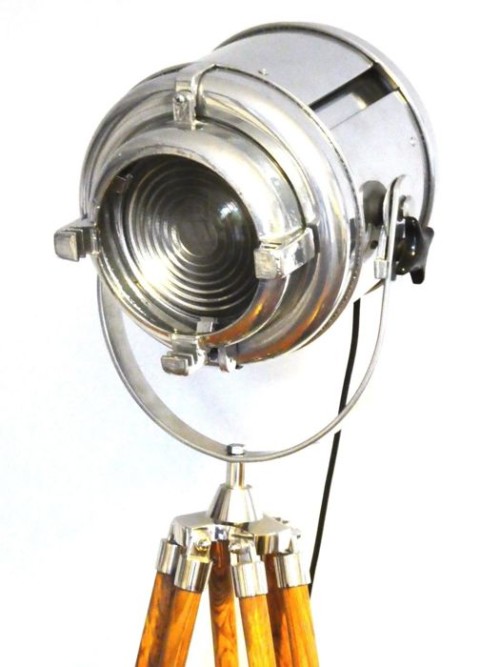
 Projecteur de théâtre de la marque Furse sur trépied Projecteur de théâtre fabriqué par Furse ligthing (Nottingham-UK) Fournis sur un trépied en bois réglable Années 50 Ré-électrifié Dimensions : H : 32 cm ; L : 27 cm ; P : 27 cm Les trépieds sont ajustable de 75 cm à 170cm
Projecteur de théâtre de la marque Furse sur trépied Projecteur de théâtre fabriqué par Furse ligthing (Nottingham-UK) Fournis sur un trépied en bois réglable Années 50 Ré-électrifié Dimensions : H : 32 cm ; L : 27 cm ; P : 27 cm Les trépieds sont ajustable de 75 cm à 170cm
Theater projector form the brand Furse, 1950s Theater projector manufactured by Furse lignthing (Nottimgham, UK) Provided on an adjustable wooden tripod 1950s Re-elected Dimensions : L : 12.6 in ; W : 10.63 in ; H : 10.63 in The height range is adjustable from 29.53 in to 66.93 in L : 32 cm ; W : 27 cm ; H : 27 cm The height range is adjustable from 75 cm to 170 cm -
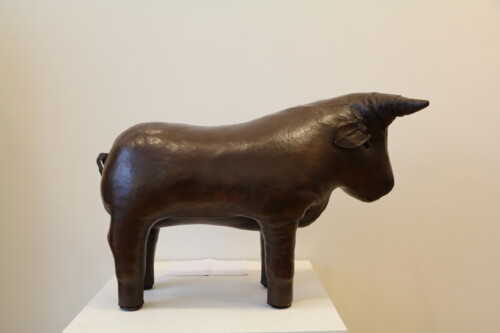
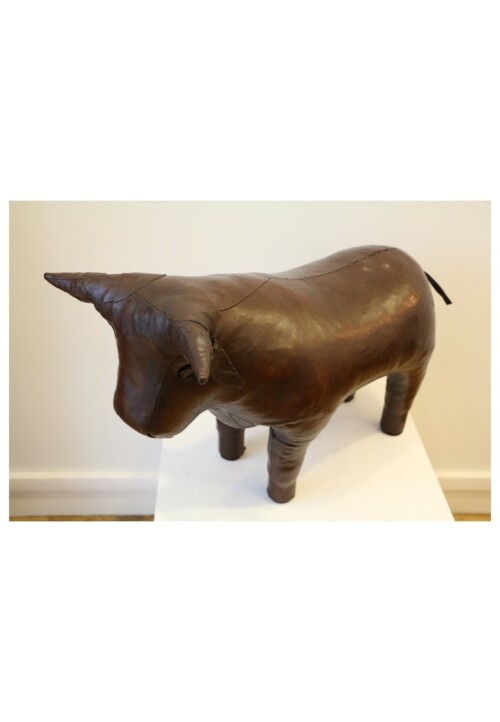 Dimitri OMERSA (1927) Repose-pied taureau en peau de porc patinée (cuir) Vers 1965 Omersa & Co., Lincolnshire pour Liberty's of London H: 44 cm ; L : 64 cm ; P : 35 cm Pour plus d'informations sur le fabricant, cliquer sur le nom : OMERSA
Dimitri OMERSA (1927) Repose-pied taureau en peau de porc patinée (cuir) Vers 1965 Omersa & Co., Lincolnshire pour Liberty's of London H: 44 cm ; L : 64 cm ; P : 35 cm Pour plus d'informations sur le fabricant, cliquer sur le nom : OMERSA
Bull Pouf or ottoman by Dimitri Omersa, circa 1965.Pouf or ottoman in patinated leather symbolizing a bull by Dimitri Omersa. Ottoman manufactured by Omersa & Co, Lincolnshire England for Liberty's of London. A Dimitri Omersa seat symbolizing a boar is also available.
Dimensions :For more information : OMERSAH : 17.32 in. ; W : 25.2 in. ; D : 13.78 in.H : 44 cm ; 64 cm ; D : 35 cm -
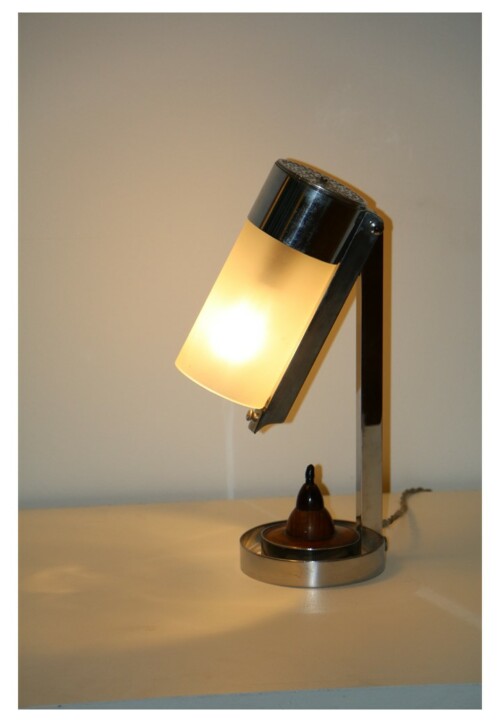
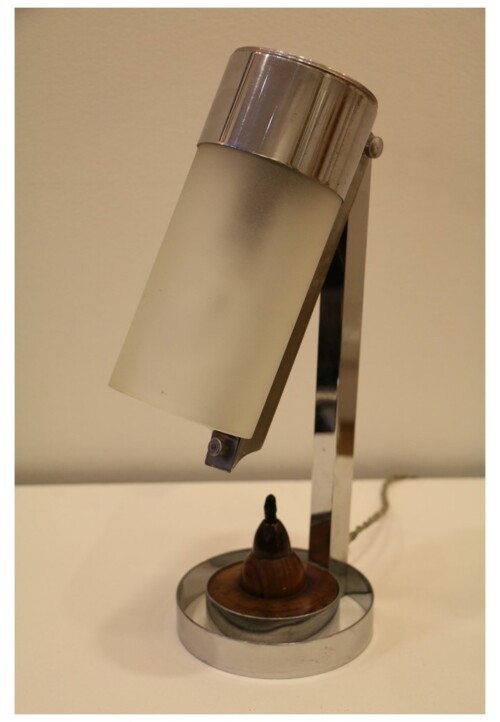 Boris LACROIX (1902-1984) Lampe moderniste en métal chromé Tête articulée sur l'axe terminée par un cylindre de verre dépoli Base en palissandre et bakélite Vers 1930 H : 31 cm ; Diamètre : 12 cm Pour plus d'informations sur le créateur, cliquer sur le nom : Boris LACROIX
Boris LACROIX (1902-1984) Lampe moderniste en métal chromé Tête articulée sur l'axe terminée par un cylindre de verre dépoli Base en palissandre et bakélite Vers 1930 H : 31 cm ; Diamètre : 12 cm Pour plus d'informations sur le créateur, cliquer sur le nom : Boris LACROIX
An Art Deco Modernist table lamp by Jean Boris Lacroix, 1930s.Modernist lamp in chrome metal, the articulated head on the shaft is ending with with a frosted glass cylinder. Bakelite switch on the wooden base. By Jean Boris Lacroix. European standard wiring.
For more information : Boris LACROIXDimensions :H : 12.2 in.H ; Diameter : 4.72 in.H : 31 cm ; Diameter : 12 cm -
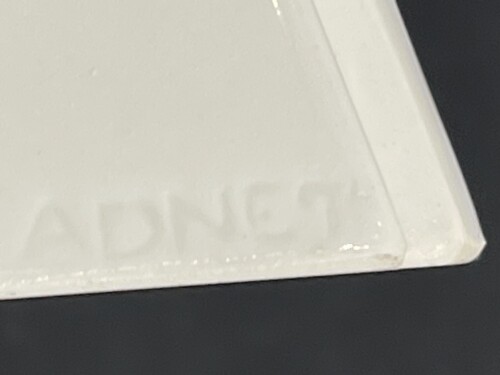
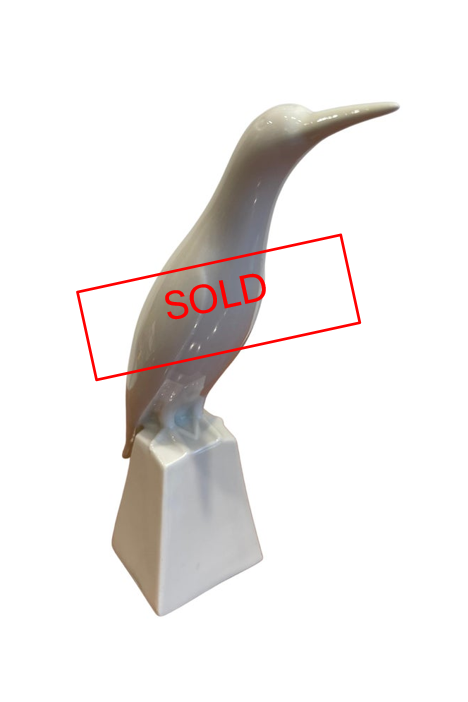 Très rare sculpture en porcelaine représentant un oiseau stylisé par Jacques Adnet (1900-1984) et fabriquée par Gérard, entreprise de porcelaine Dufraissex et Abbot basée à Limoges pour la Compagnie des Arts Français. Porcelaine émaillée ivoire, vers 1930. Signée ADNET sur la base, porte la marque du fabricant à l'intérieur de la base. Hauteur : 20 cm. Condition parfaite. Bibliographie : Les Echos des Industries d'Art - N° 40 de novembre 1928 : modèle identique reproduit page 14. Pour plus d'informations sur Jacques Adnet, cliquez ici. Very rare porcelain sculpture representing a stylized bird by Jacques Adnet (1900-1984) and manufactured by Gérard, Dufraissex et Abbot porcelain company based in Limoges for Compagnie des Arts Français. Porcelain with ivory enamel, circa 1930. Signed ADNET on the base, wears the mark of the manufacturer inside the base. Height: 20cm. Perfect condition. Bibliography : Les Echos des Industries d'Art - N° 40 dated November 1928 : identical model reproduced page 14. For more information about Jacques Adnet, click here.
Très rare sculpture en porcelaine représentant un oiseau stylisé par Jacques Adnet (1900-1984) et fabriquée par Gérard, entreprise de porcelaine Dufraissex et Abbot basée à Limoges pour la Compagnie des Arts Français. Porcelaine émaillée ivoire, vers 1930. Signée ADNET sur la base, porte la marque du fabricant à l'intérieur de la base. Hauteur : 20 cm. Condition parfaite. Bibliographie : Les Echos des Industries d'Art - N° 40 de novembre 1928 : modèle identique reproduit page 14. Pour plus d'informations sur Jacques Adnet, cliquez ici. Very rare porcelain sculpture representing a stylized bird by Jacques Adnet (1900-1984) and manufactured by Gérard, Dufraissex et Abbot porcelain company based in Limoges for Compagnie des Arts Français. Porcelain with ivory enamel, circa 1930. Signed ADNET on the base, wears the mark of the manufacturer inside the base. Height: 20cm. Perfect condition. Bibliography : Les Echos des Industries d'Art - N° 40 dated November 1928 : identical model reproduced page 14. For more information about Jacques Adnet, click here. -
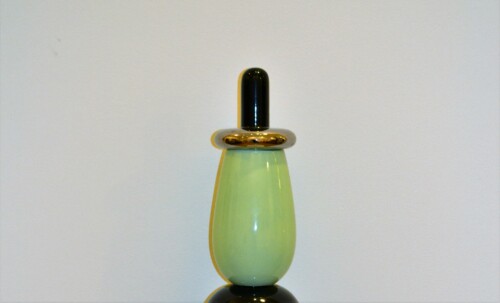
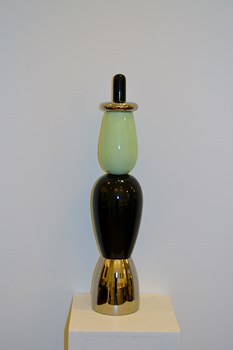 Alessandro MENDINI (1931 - ) Colonne stylobate Collection Colonne 2008. Editions Superego limitée à cinquante exemplaires (n°5 ici) Boite haute en faïence émaillée Signée du designer et de l'éditeur, numérotée 5/50. H : 72 cm ; Diamètre : 15 cm Pour plus d'informations sur le créateur, cliquer sur le nom : Alessandro MENDINI
Alessandro MENDINI (1931 - ) Colonne stylobate Collection Colonne 2008. Editions Superego limitée à cinquante exemplaires (n°5 ici) Boite haute en faïence émaillée Signée du designer et de l'éditeur, numérotée 5/50. H : 72 cm ; Diamètre : 15 cm Pour plus d'informations sur le créateur, cliquer sur le nom : Alessandro MENDINI
Stilobate column by Alessandro Mendini, 2008.Stilobate column from the Column Collection created in 2008 by Alessandro Mendini (born in 1931). Superego Edition limited to 50 numbered copies. The column is surmounted by a box with a lid. Black, green and chrome enameled porcelain.
Signed under the base by the designer and the editor and numbered 5/50.
Dimensions :H : 28.35 in. ; Diameter : 5.91 in.H : 72 cm ; Diameter : 15 cmFor more information : Alessandro MENDINI
-
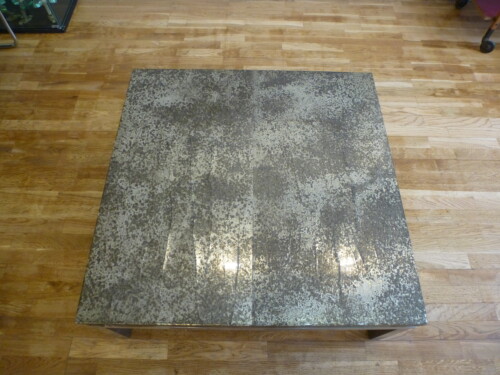
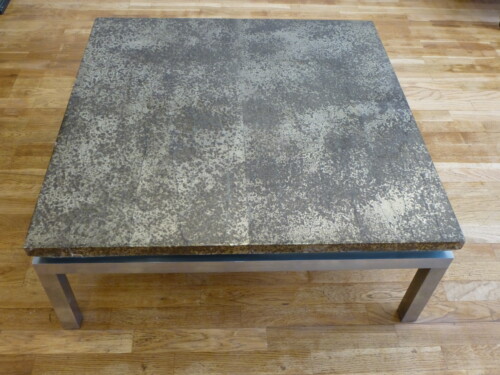 Table basse, travail des années 1970 Piètement en métal et plateau laqué or H : 35 cm ; L : 90 cm ; P : 90 cm
Table basse, travail des années 1970 Piètement en métal et plateau laqué or H : 35 cm ; L : 90 cm ; P : 90 cm
Large square coffee table, 1970s.Large square coffee table with stainless steel base square section.
Top covered with a sheet of acid oxidized brass coated with a clear lacquer cracked like the ancient Chinese lacquer.
Dimensions :H : 13.78 in. ; W : 35.43 in. ; D : 35.43 in.H : 35 cm ; W : 90 cm ; D : 90 cm -
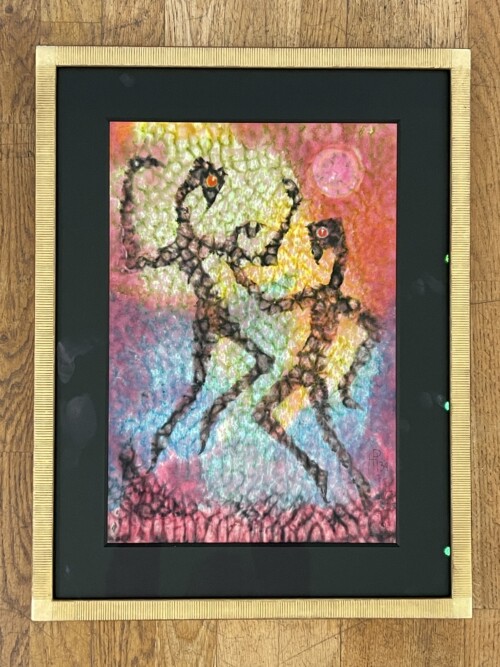
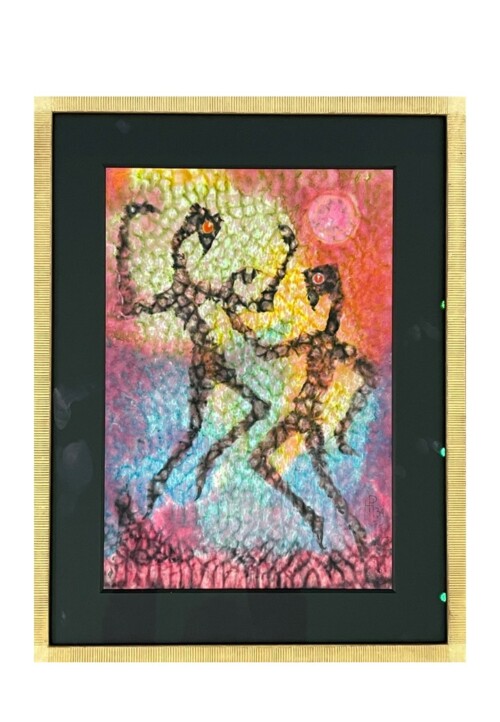 PFEIFFER Herni Ernst (1907-1994) « Pas de deux », 1931, aquarelle, Monogrammée et datée en bas à droite. Dimensions : 42 x29 cm Henri Pfeiffer est un artiste allemand qui commence ses études artistiques à l’université de Bonn puis au Bauhaus auprès de Paul Klee et de Kandinsky. Ses créations sont marquées par un sens du mouvement, du dynamisme et de la couleur proche des avant-gardes européennes. Ses personnages dansants aux corps anguleux qui viennent se distinguer du fond coloré traduisent une atmosphère dansante et envoûtante. Henri Pfeiffer a longuement travaillé sur la technique picturale, sur les différentes manières de développer une peinture. Ainsi ses œuvres sont réalisées avec des techniques expérimentales que l’artiste développe comme cette aquarelle réalisée avec des pigments non miscibles. Le rendu est d’une extrême originalité et permet d’accentuer l’éclat des couleurs et la sensation de mouvement. Arrêté par la Gestapo à la dissolution du Bauhaus en 1933 il ne reprendra jamais la peinture et devient médecin ophtalmologue spécialisé dans la perception des couleurs. Il y consacre notamment un livre en 1956 “l’Harmonie des Couleurs’’ et enseigne la chromatologie à Paris (où il s'est installé après la guerre) à l’Ecole des Arts Appliqués dès 1960. Cette œuvre est titrée “Pas de deux”, elle est monogrammée et datée en bas à droite. Pour découvrir l'artiste cliquez ici
PFEIFFER Herni Ernst (1907-1994) « Pas de deux », 1931, aquarelle, Monogrammée et datée en bas à droite. Dimensions : 42 x29 cm Henri Pfeiffer est un artiste allemand qui commence ses études artistiques à l’université de Bonn puis au Bauhaus auprès de Paul Klee et de Kandinsky. Ses créations sont marquées par un sens du mouvement, du dynamisme et de la couleur proche des avant-gardes européennes. Ses personnages dansants aux corps anguleux qui viennent se distinguer du fond coloré traduisent une atmosphère dansante et envoûtante. Henri Pfeiffer a longuement travaillé sur la technique picturale, sur les différentes manières de développer une peinture. Ainsi ses œuvres sont réalisées avec des techniques expérimentales que l’artiste développe comme cette aquarelle réalisée avec des pigments non miscibles. Le rendu est d’une extrême originalité et permet d’accentuer l’éclat des couleurs et la sensation de mouvement. Arrêté par la Gestapo à la dissolution du Bauhaus en 1933 il ne reprendra jamais la peinture et devient médecin ophtalmologue spécialisé dans la perception des couleurs. Il y consacre notamment un livre en 1956 “l’Harmonie des Couleurs’’ et enseigne la chromatologie à Paris (où il s'est installé après la guerre) à l’Ecole des Arts Appliqués dès 1960. Cette œuvre est titrée “Pas de deux”, elle est monogrammée et datée en bas à droite. Pour découvrir l'artiste cliquez ici
Henri Pfeiffer is a German artist who pursued artistic studies at the University of Bonn and later at the Bauhaus under the guidance of Paul Klee and Kandinsky. His creations are characterized by a sense of movement, dynamism, and color, closely tied to European avant-gardes. His dancing figures with angular bodies, distinct from the colorful backgrounds, convey a captivating and enchanting atmosphere. Henri Pfeiffer extensively explored pictorial techniques and different ways of developing paintings. As a result, his works were created using experimental techniques that the artist developed, such as this watercolor made with non-miscible pigments. The outcome is extremely original, emphasizing the brilliance of colors and the sensation of movement. Arrested by the Gestapo during the dissolution of the Bauhaus in 1933, he never returned to painting and became an ophthalmologist, a recognized specialist in color perception. He dedicated a book to this subject in 1956, titled 'L’Harmonie des Couleurs' (The Harmony of Colors), and taught chromatology in Paris (where he settled after the war) at the School of Applied Arts from 1960. This artwork is titled 'Pas de Deux,' monogrammed, and dated at the bottom right. For more informations about Henri Pfeiffer, please click here Dimensions : 42 x 29 cm 16.53 x 11.41 inches -
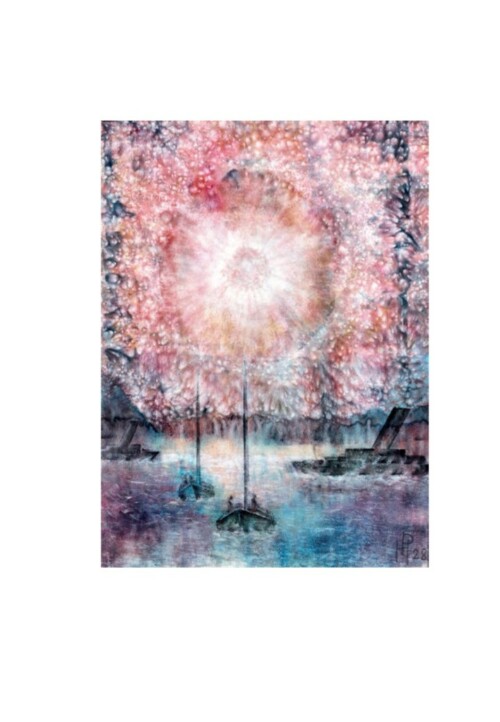 Henri PFEIFFER (1907-1994) Technique mixte représentant des navires de style cubiste, sous un feu d'artifice. Monogrammée "HP" et datée "28" Au revers inscription de la main de l'artiste : "Cette aquarelle signée HP28 est originale de mon époque Bauhaus". Signée Pfeiffer avec une autre inscription en bas à droite : " Ancien élève de Paul Klee". Dimensions : H : 46 cm ; L : 33,5 cm (sans cadre) H : 61 cm ; L : 49,3 cm (avec cadre) Pour plus d'informations sur le créateur, cliquer sur le nom : Henri PFEIFFER
Henri PFEIFFER (1907-1994) Technique mixte représentant des navires de style cubiste, sous un feu d'artifice. Monogrammée "HP" et datée "28" Au revers inscription de la main de l'artiste : "Cette aquarelle signée HP28 est originale de mon époque Bauhaus". Signée Pfeiffer avec une autre inscription en bas à droite : " Ancien élève de Paul Klee". Dimensions : H : 46 cm ; L : 33,5 cm (sans cadre) H : 61 cm ; L : 49,3 cm (avec cadre) Pour plus d'informations sur le créateur, cliquer sur le nom : Henri PFEIFFER
A Bauhaus painting by Henri Pfeiffer 1928.
Painting with cubist style by Henri Pfeiffer (1907-1994).
Monogrammed "HP" and dated "28"
On the reverse listing of the hand of the artist: "This watercolor signed HP28 is my original Bauhaus era." Signed Pfeiffer with another entry on the lower right: "A former student of Paul Klee".
Henri Pfeiffer joined the Bauhaus at the age of 17 where he became a student of Paul Klee. He created many abstract works with a renewed vision of the use and perception of colors. Very young, he studied intensively the chemistry of pigments with his uncle. In 1933 when the Bauhaus was forbidden he was arrested by the Gestapo but he succeed to be released with the help of his parents. He then abandonned painting but still got passionate with colors becoming a famous ophtalmologist specialized in the perception of colors. He wrote a book about the subject in the 1950’s. This early genius artist, who produced an avant-garde painting work with a fascinating research on colors, is a real discovery. His history and his journey from art to science with the continuous obsession of color perception understanding is fascinating and very consistent with the ethical and philosophical Bahaus principles which never separated art from science and industy.
Dimensions :H : 18.11 in. ; W : 13.2 in.H : 46 cm ; W : 33,5 cmFor more information : Henri PFEIFFER
-
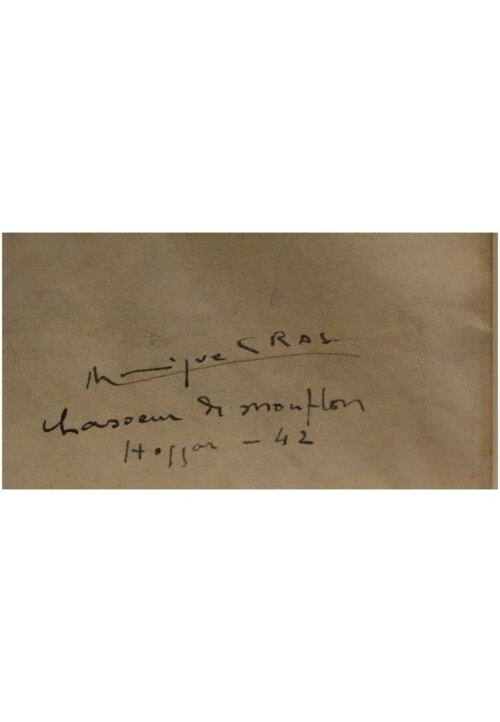
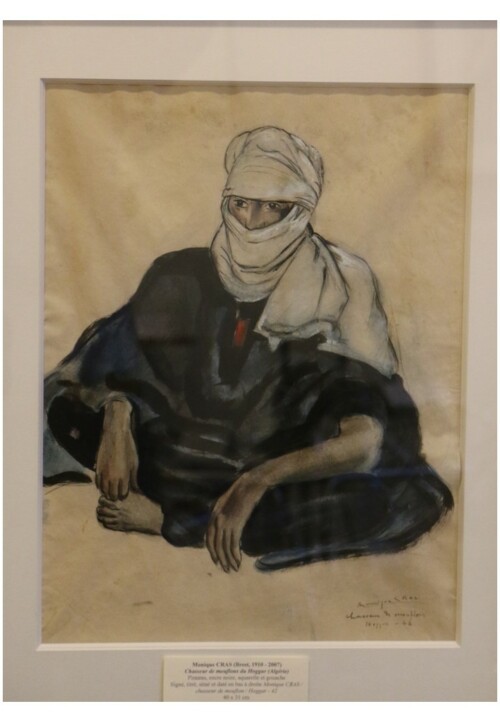 Monique CRAS Gouache titrée Chasseur de mouflon - Hoggar Pinceau, encre noire, aquarelle et gouache représentant un homme assis Signée Monique Cras et datée 42 (1942) Dimensions : H : 40 cm ; L : 31 cm (sans le cadre) H : 67,3 cm ; L : 54 cm (avec le cadre) Pour plus d’informations sur le créateur, cliquer sur le nom : Monique CRAS
Monique CRAS Gouache titrée Chasseur de mouflon - Hoggar Pinceau, encre noire, aquarelle et gouache représentant un homme assis Signée Monique Cras et datée 42 (1942) Dimensions : H : 40 cm ; L : 31 cm (sans le cadre) H : 67,3 cm ; L : 54 cm (avec le cadre) Pour plus d’informations sur le créateur, cliquer sur le nom : Monique CRAS
'Touareg in Hoggar' Gouache by Monique Cras, Art Deco, 1942.Gouache depicting a seated Touareg (also called blue man of the desert because of their indigo dyed clothing). The painting is signed Monique Cras, dated 1942 and titled 'Chasseur de mouflon dans le Hoggar' (Mouflon Hunter in the Hoggar). The Hoggar is a mountain range in southern Algeria.
Dimensions : (with frame)H : 26.38 in. ; W : 21.26 in. ; D : 1.18 in.H :67 cm ; W : 54 cm ; D : 3 cm(painting)H : 35.35 in. ; W : 11.81 in.H : 39 cm ; W : 30 cmFor more informations : Monique CRAS -
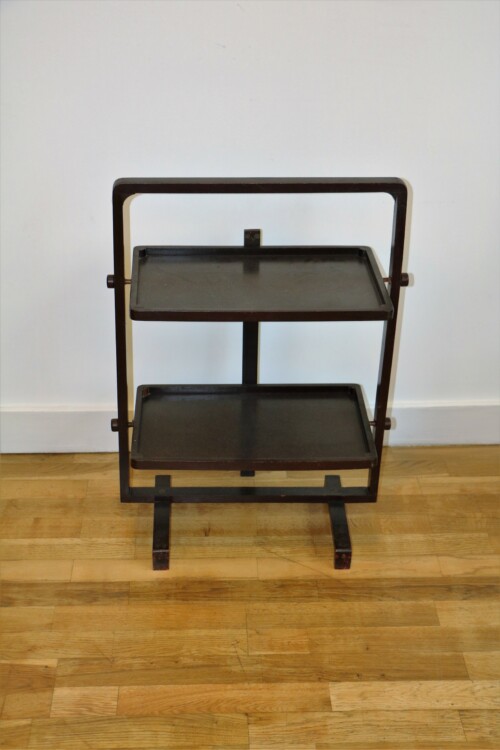
 André GROULT (1884-1966) Desserte Geisha pliantes en bois teinté à deux plateaux Vers 1930 H : 68 cm ; L : 52 cm ; P : 29 cm Pour plus d'informations sur le créateur, cliquer sur le nom : André GROULT
André GROULT (1884-1966) Desserte Geisha pliantes en bois teinté à deux plateaux Vers 1930 H : 68 cm ; L : 52 cm ; P : 29 cm Pour plus d'informations sur le créateur, cliquer sur le nom : André GROULT
An Art Deco folding side table by André Groult, circa 1930.A very elegant folding side table by André Groult, circa 1930.
This model is knowed as Geisha due to its Japanese inspiration.
Stained wood with two trays.
Dimensions :H : 26.77 in. ; W : 20.47 in. ; D : 11.42 in. ; L : 26.77 in.H : 68 cm ; W : 52 cm ; D : 29 cm ; L : 68cmFor more information : André GROULT -
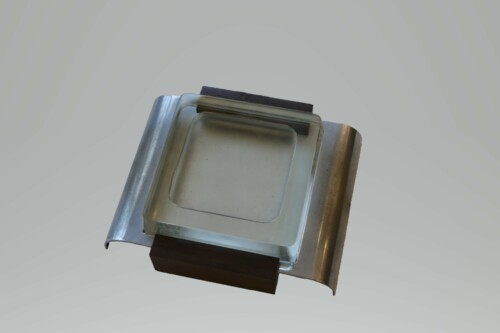
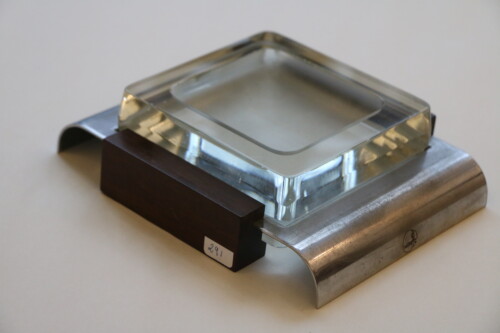 Jean Boris Lacroix (1902-1984) Vide poche moderniste En métal nickelé, verre et palissandre Signé de la marque H : 6.3 cm ; L : 22 cm Pour plus d’informations sur le créateur, cliquer sur le nom : Jean Boris LACROIX
Jean Boris Lacroix (1902-1984) Vide poche moderniste En métal nickelé, verre et palissandre Signé de la marque H : 6.3 cm ; L : 22 cm Pour plus d’informations sur le créateur, cliquer sur le nom : Jean Boris LACROIX
Modernist Pin Tray/Vide Poche by Jean Boris Lacroix Nickel-plated metal, glass and rosewood Signed by the brand Dimensions : H : 6.3 cm ; W : 22 cm H : 2.49 in ; W : 8.47 in For more information : Jean Boris LACROIX -
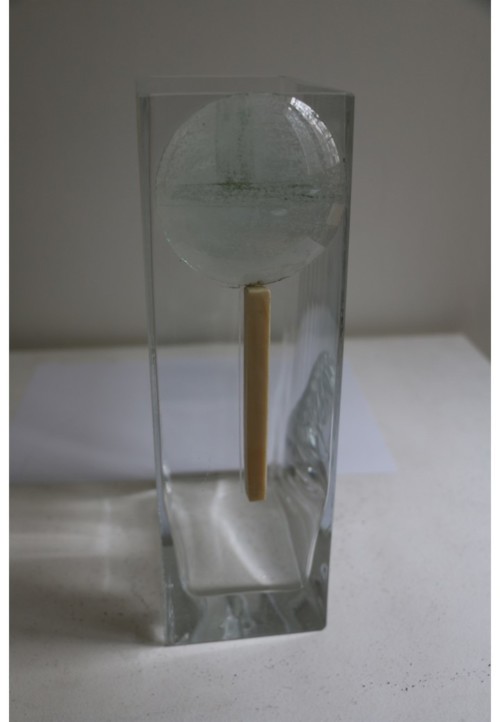
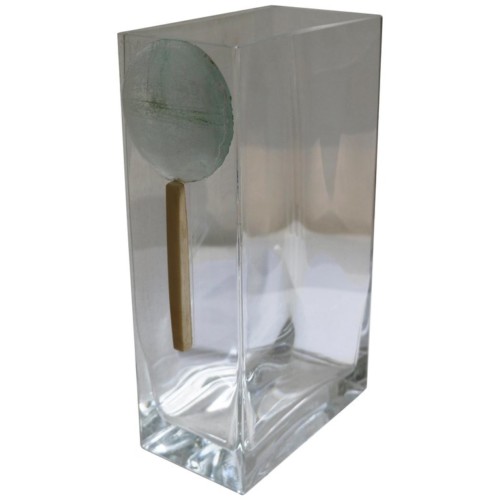 A. Riecke — Vase Art-Déco Vase Art-Déco gravé d’un décor cubisant. Signé et daté 4.8.39. H : 27 cm ; L : 15 cm ; P : 8,5 cm A. Riecke, artiste russe, installé à Paris a été responsable du décor en verrerie Art Déco de 1930 à 1937 du restaurant La Coupole à Paris. Le Restaurant La Coupole est le temple de l’Art Déco. Il naît en 1927 de la volonté de deux Auvergnats, Ernest Fraux et René Lafon. Le soir de l’inauguration, tout le monde des Arts, des Lettres, de la nuit est là : des artistes et leurs modèles, des mondains et des flambeurs.
A. Riecke — Vase Art-Déco Vase Art-Déco gravé d’un décor cubisant. Signé et daté 4.8.39. H : 27 cm ; L : 15 cm ; P : 8,5 cm A. Riecke, artiste russe, installé à Paris a été responsable du décor en verrerie Art Déco de 1930 à 1937 du restaurant La Coupole à Paris. Le Restaurant La Coupole est le temple de l’Art Déco. Il naît en 1927 de la volonté de deux Auvergnats, Ernest Fraux et René Lafon. Le soir de l’inauguration, tout le monde des Arts, des Lettres, de la nuit est là : des artistes et leurs modèles, des mondains et des flambeurs.